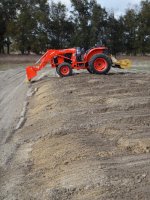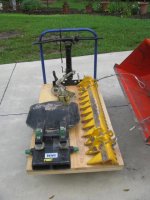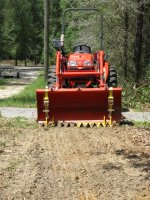We are only going to start on 1/2 acre to 1 acre max this season. Pasture will be limited as we do not intend to have cattle but goats, chickens, and rabbits. About 10 acres is all that is tillable. Slope is minimal. We have a piece picked out that is relatively flat with good drainage off 2 sides.
We are planning to plant sweet corn, beans, squash, spinach, carrots, and beets.
Yes, we have a earth/gravel drive to maintain.
We will have firewood as a supplemental heat source to LPG.
There is wild game in the area though we are not planting for them. We will be wanting to keep them out of the crops, especially the deer and rabbits. Ideas or suggestions on that would be welcomed.
I do not have tractor experience though I have maintained my cars and motorcycles since I was 14. I do intend to service our tractor myself. We are getting a manual to help with that.
To start cultivation there are two ways to go.
1. "Open" ground with a Moldboard Plow, preferably in the late Fall, then, in early Spring, break up the deep furrows and clods left by the plow with multiple passes with a Disc Harrow, then drag to flatten further, then sow and roll in seed. If you intended to cultivate 20+ acres for cash crops this would be the way to go.
2. For your half to one acre this year, with incremental annual growth, a tractor Three Point Hitch mounted, Power-Take-Off (PTO) powered Roto-tiller is the route to go. One or two passes and you will be ready to plant veggies. Roto-tillers for small tractors come in sizes from 42" to 84" wide. (Roto-tillers and Disc Harrows are both tillers.)
You will want a tractor with a Front End Loader (FEL) which you can think of as a powered, elevating wheelbarrow.
This is the most common small tractor option. Almost everyone who writes here has one on their 20-50 horsepower tractor. Most tractors with an FEL also come with Four Wheel Drive (4-WD) for traction, which is necessary to fill the FEL bucket. FEL is used to move soil, dung, firewood, harvested crops, building materials, tools, fertilizer, etc. A great productivity multiplier.
The smallest tractors are called sub-compacts. (SCUTS). Most here would agree they range 16-20 engine horsepower, have nine inches ground clearance and usually a two-speed semi-automatic Hydrostatic transmission. (HST).
The next larger tractor category is called compact utility tractors (CUTS). CUTS have 20-45 engine horsepower and the most common size of Three Point Hitch (3-PT), a Category '1'. CUTS have 12" - 14" of ground clearance. This is the category of tractor you will want. You will need to do a lot of research to decide on how heavy and how powerful a tractor your needs require and what you can afford.
If your gravel drive is in good shape you may be able to maintain it with only a Ratchet Rake attachment on the FEL bucket. For your garden, in addition to a PTO roto-tiller you will need a one row or two row cultivator.
From here, the list of useful bucket attachments and 3-Pt implements used in farming is infinite.
Observe what farmers in your area use to keep deer out of their crops. I am retired from the California wine industry. Where we raised wine grapes in hilly areas, ten foot fences were required to keep deer out. On flat land perhaps lower fences would suffice.
Ask tractor questions in the OWNING & OPERATING Forum.
Good luck.
LINKS:
TractorData.com - Three-Point Hitch
Iowa Farm Equipment -- Rotary Tillers & Power Harrows
Tractor Cultivator 3 Point Hitch, Single Row & Field Cultivators for Cultivating Potatoes, tomatoes and other crops
http://www.lsuagcenter.com/NR/rdonl...45263BDD8/11557/pub2917tractorimplements1.pdf
http://www.tractorbynet.com/forums/...ons/312467-need-help-selecting-tractor-2.html


